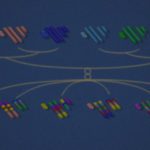Link to Pubmed [PMID] – 10839719
Exp. Dermatol. 2000 Jun; 9(3): 206-18
Lanceolate hair-J (lahJ) arose spontaneously in 1994 on the DBA/1LacJ inbred background at The Jackson Laboratory. Mutant mice were runted, alopecic, and lacked vibrissae. As they aged, their skin wrinkled. Affected mice developed a noninflammatory, proliferative skin disease with follicular dystrophy. Hair fibers developed a number of abnormalities including periodic nodules along the shaft (trichorrhexis nodosa), compaction resembling trichorrhexis invaginata, spiral fractures, broken tips, and lance-shaped tips. This mutation exhibits some characteristics that resemble an autosomal recessive ichthyosiform disease that occurs in humans characterized in part by peculiar, invaginating, multinodal, hair shaft abnormalities known as Netherton’s syndrome. Periodic nodules also resemble the human genetic based disease monilethrix. This autosomal recessive mouse mutation, allelic with lanceolate hair (lah), based on breeding studies, is located on mouse Chromosome 18, within a cluster of genes coding for adhesion molecules. Homozygotes for either of these allelic mouse mutations have elevated serum IgE levels, a feature also common with human Netherton’s syndrome.

